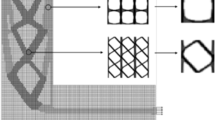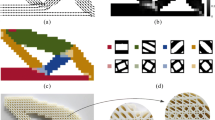Abstract
Due to multiple local optimums in the society of periodic material microstructure deign using topology optimization, it is widely recognized that the initial microstructure configuration can significantly influence the optimal design. This study investigates the effect of different initial material layouts of microstructure unit cell upon the optimal design, and proposes a microstructure initialization scheme to alleviate the dependency of the optimal design on its initial design. The effective elastic properties of microstructures are evaluated by the efficient energy-based homogenization method. Topology optimization models are formulated to seek the best microstructures with the extreme properties or desired properties under the prescribed volume constraints. Several typical numerical examples are presented to demonstrate the effectiveness of the proposed scheme. Numerical results show that the proposed scheme can reduce the sensitivity of the optimal design upon optimization parameters and be beneficial to achieve a stable and rapid convergence.
Similar content being viewed by others
References
X. Huang, A. Radman and Y. M. Xie, Topological design of microstructures of cellular materials for maximum bulk or shear modulus, Computational Materials Science, 50 (6) (2011) 1861–1870.
Y. Zhang, M. Xiao, H. Li, L. Gao and S. Chu, Multiscale concurrent topology optimization for cellular structures with multiple microstructures based on ordered SIMP interpolation, Computational Materials Science, 155 (2018) 74–91.
Y. Wang, Z. Luo, N. Zhang and Z. Kang, Topological shape optimization of microstructural metamaterials using a level set method, Computational Materials Science, 87 (2) (2014) 178–186.
J. Gao, H. Li, L. Gao and M. Xiao, Topological shape optimization of 3D micro–structured materials using energybased homogenization method, Advances in Engineering Software, 116 (2018) 89–102.
O. Sigmund and K. Maute, Topology optimization approaches. Structural & Multidisciplinary Optimization, 48 (6) (2013) 1031–1055.
D. Lee and S. Shin, Extended–finite element method as analysis model for Gauss point density topology optimization method, Journal of Mechanical Science and Technology, 29 (4) (2015) 1341–1348.
J. Du and R. Yang, Vibro–acoustic design of plate using bimaterial microstructural topology optimization, Journal of Mechanical Science and Technology, 29 (4) (2015) 1413–1419.
A. Li, C. Liu and S. Feng, Topology and thickness optimization of an indenter under stress and stiffness constraints, Journal of Mechanical Science and Technology, 32 (1) (2018) 211–222.
J. Hur, P. Kang and S. K. Youn, Topology optimization based on spline–based meshfree method using topological derivatives, Journal of Mechanical Science and Technology, 31 (5) (2017) 2423–2431.
M. P. Bendsøe and N. Kikuchi, Generating optimal topologies in structural design using a homogenization method, Computer Methods in Applied Mechanics & Engineering, 71 (2) (1988) 197–224.
J. Guedes and N. Kikuchi, Preprocessing and postprocessing for materials based on the homogenization method with adaptive finite element methods, Computer Methods in Applied Mechanics & Engineering, 83 (2) (1990) 143–198.
Y. M. Xie and G. P. Steven, A simple evolutionary procedure for structural optimization, Computers & Structures, 49 (5) (1993) 885–896.
X. Huang and Y. M. Xie, Evolutionary Topology Optimization of Continuum Structures: Methods and Applications, John Wiley & Sons, Chichester (2010).
X. Huang and Y. M. Xie, Bi–directional evolutionary topology optimization of continuum structures with one or multiple materials, Computational Mechanics, 43 (3) (2009) 393–401.
O. M. Querin, V. Young, G. P. Steven and Y. M. Xie, Computational efficiency and validation of bi–directional evolutionary structural optimization, Computer Methods in Applied Mechanics & Engineering, 189 (2) (2000) 559–573.
M. P. Bendsøe and O. Sigmund, Topology Optimization: Theory, Methods and Applications, Springer Verlag (2003).
M. P. Bendsøe and O. Sigmund, Material interpolation schemes in topology optimization, Archive of Applied Mechanics, 69 (9–10) (1999) 635–654.
Z. Kang and Y. Wang, Structural topology optimization based on non–local Shepard interpolation of density field, Computer Methods in Applied Mechanics & Engineering, 200 (49–52) (2011) 3515–3525.
Z. Luo, N. Zhang, Y. Wang and W. Gao, Topology optimization of structures using meshless density variable approximants, International Journal for Numerical Methods in Engineering, 93 (4) (2013) 443–464.
N. P. V. Dijk, K. Maute, M. Langelaar and F. V. Keulen, Level–set methods for structural topology optimization: A review, Structural & Multidisciplinary Optimization, 48 (3) (2013) 437–472.
A. L. Gain and G. H. Paulino, A critical comparative assessment of differential equation–driven methods for structural topology optimization, Structural & Multidisciplinary Optimization, 48 (4) (2013) 685–710.
S. M. Lee and S. Y. Han, Topology optimization based on the harmony search method, Journal of Mechanical Science and Technology, 31 (6) (2017) 2875–2882.
A. R. Aderiani, M. Shariatpanahi and A. Parvizi, Simultaneous topology and size optimization of locomotive structure using multinary genetic algorithms, Journal of Mechanical Science and Technology, 31 (3) (2017) 1283–1291.
K. S. Yoo and S. Y. Han, Topology optimum design of compliant mechanisms using modified ant colony optimization, Journal of Mechanical Science and Technology, 29 (8) (2015) 3321–3327.
O. Sigmund, Materials with prescribed constitutive parameters: an inverse homogenization problem, International Journal of Solids and Structures, 31 (17) (1994) 2313–2329.
O. Sigmund, Tailoring materials with prescribed elastic properties, Mechanics of Materials, 20 (1995) 351–368.
L. V. Gibiansky and O. Sigmund, Multiphase composites with extremal bulk modulus, Journal of the Mechanics & Physics of Solids, 48 (3) (2000) 461–498.
M. M. Neves, H. Rodrigues and J. M. Guedes, Optimal design of periodic linear elastic microstructures, Computers & Structures, 76 (1) (2000) 421–429.
O. Sigmund and S. Torquato, Design of materials with extreme thermal expansion using a three–phase topology optimization method, Journal of the Mechanics and Physics of Solids, 45 (6) (1997) 1037–1067.
O. Sigmund and S. Torquato, Composites with extremal thermal expansion coefficients, Applied Physics Letters, 69 (21) (1996) 3203–3205.
X. Huang, S. Zhou, G. Sun, G. Li and Y. M. Xie, Topology optimization for microstructures of viscoelastic composite materials, Computer Methods in Applied Mechanics & Engineering, 283 (253) (2015) 503–516.
E. Andreassen and J. S. Jensen, Topology optimization of periodic microstructures for enhanced dynamic properties of viscoelastic composite materials, Structural & Multidiscipli nary Optimization, 49 (5) (2013) 695–705.
R. Grimberg, Electromagnetic metamaterials, Materials Science & Engineering B, 178 (19) (2013) 1285–1295.
S. Zhou, W. Li, G. Sun and Q. Li, A level–set procedure for the design of electromagnetic metamaterials, Optics Express, 18 (7) (2010) 6693–702.
E. Andreassen, B. S. Lazarov and O. Sigmund, Design of manufacturable 3D extremal elastic microstructure, Mechanics of Materials, 69 (1) (2014) 1–10.
F. Wang, O. Sigmund and J. S. Jensen, Design of materials with prescribed nonlinear properties, Journal of the Mechanics & Physics of Solid, 69 (1) (2014) 156–174.
S. Zhou and Q. Li, Computational design of multi–phase microstructural materials for extremal conductivity, Computational Materials Science, 43 (3) (2008) 549–564.
S. Zhou and Q. Li, Design of graded two–phase microstructures for tailored elasticity gradients, Journal of Materials Science, 43 (15) (2008) 5157–5167.
W. Zhang, F. Wang, G. Dai and S. Sun, Topology optimal design of material microstructures using strain energy–based method, Chinese Journal of Aeronautics, 20 (4) (2007) 320–326.
W. Zhang, G. Dai, F. Wang, S. Sun and H. Bassir, Using strain energy–based prediction of effective elastic properties in topology optimization of material microstructures, Acta Mechanica Sinica, 23 (1) (2007) 77–89.
L. Xia and P. Breitkopf, Design of materials using topology optimization and energy–based homogenization approach in Matlab, Structural & Multidisciplinary Optimization, 52 (6) (2015) 1229–1241.
S. Xu, B. Niu and G. Cheng, Crystal nucleus methods for material design, Chinese Journal of Solid Mechanics, 31 (4) (2010) 369–378.
G. W. Milton and N. P. Thien, New bounds on effective elastic moduli of two–component materials, Proceedings of the Royal Society of London, 380 (1779) (1982) 305–331.
Author information
Authors and Affiliations
Corresponding author
Additional information
Recommended by Associate Editor Gil Ho Yoon
Yan Zhang is currently a doctoral student at Huazhong University of Science and Technology in China. His main research interest includes topological design of material microstructure, integrated topological design of material and structure.
Mi Xiao is currently a lecturer at Huazhong University of Science and Technology in China. His main research interest includes topology optimization, multidisciplinary design optimization, design optimization based on surrogate model.
Hao Li is currently a post-doctoral researcher at Huazhong University of Science and Technology in China. His main research interest includes topology optimization, integrated topological design of material and structure.
Liang Gao is a Professor at Huazhong University of Science and Technology in China. His main research interest includes topology optimization, intelligent optimization algorithm and its application in design and manufacture.
Rights and permissions
About this article
Cite this article
Zhang, Y., Xiao, M., Li, H. et al. Topology optimization of material microstructures using energy-based homogenization method under specified initial material layout. J Mech Sci Technol 33, 677–693 (2019). https://doi.org/10.1007/s12206-019-0123-6
Received:
Revised:
Accepted:
Published:
Issue Date:
DOI: https://doi.org/10.1007/s12206-019-0123-6




